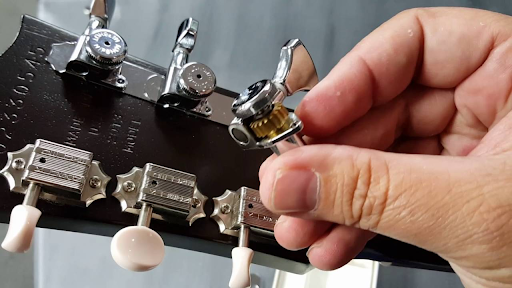How to Adjust Locking Tuners for Perfect Pitch?
How to Adjust Locking Tuners for Perfect Pitch?
Locking machine heads or tuners are popular among guitarists because they are convenient and provide stability. However, they can be complicated for beginners due to the extra step in the tuning process and the challenge of achieving perfect pitch.
Yet, with a little understanding and the right technique, you can master your tuners and keep your guitar in tune. This article will show you how to adjust the locking tuners on your guitar, from stringing the guitar to getting the perfect pitch.
We’ll also talk about common misunderstandings about locking posts and tuning stability.
Understanding Locking Posts/Tuners
These fine-tuning machines are different from traditional tuners because they have a mechanism that clamps the string in place. This prevents the string from slipping, which is a common issue with traditional tuners, especially during aggressive playing or frequent string bends.
Here’s a breakdown of the key components:
Locking Screw: This screw secures the string within the tuner post. Tightening it clamps the string, preventing it from slipping.
Clamp: This is the part that physically grips the string when the locking screw is tightened.
Stringing Your Guitar with Locking Posts
Stringing your guitar with the locking posts/tuners is a slightly different process compared to traditional tuners. Here’s a step-by-step guide:
Prepare your string: Unspool the new string and cut it to the appropriate length, leaving enough slack to wind around the tuning post.
Insert the string: Feed the string through the hole in the tuning post from the front of the headstock. Depending on the tuner design, you might have to insert it from the back. Refer to your guitar’s manual for specific instructions.
Wind the string: Turn the tuning post clockwise to wind the string onto the post. Unlike traditional tuners, you don’t need to worry about excessive winding because the locking mechanism will secure the string. Aim for 3-4 full wraps around the post for stability.
Clamp the string: Once you have enough tension on the string, tighten the locking screw using a small screwdriver or Allen wrench (depending on the tuner design). Don’t over tighten it, a snug fit is sufficient.
Tune to pitch: Use a chromatic tuner (electronic or phone app) to tune the string to the desired pitch. You can now stretch the string by gently pulling it upwards a few times. This helps remove any slack and improves tuning stability.
Fine-tune: Retune the string using the tuning peg as needed. Repeat steps 1-6 for all the strings.
Tip: It’s a good practice to slightly de-tune the string before bringing it up to pitch. This helps settle the string in the nut and bridge slots, further enhancing tuning stability.
Achieving Perfect Pitch with Locking Posts/Tuners
The locking posts/tuners do not guarantee a perfect pitch. Tuning by ear or using a tuner remains essential. However, their stability allows for more precise tuning adjustments and helps maintain that perfect pitch for longer durations.
Here are some tips for achieving perfect pitch with locking tuners:
Use a reliable tuner: Invest in a good-quality chromatic tuner. This will provide accurate reference pitches for each string.
Train your ear: While tuners are helpful, developing your ear for pitch recognition is an invaluable skill. Practice matching notes with reference tones online or using tuning forks.
Tune in a quiet environment: Background noise can make it difficult to discern subtle pitch variations. Find a quiet space to tune your guitar.
Take your time: Don’t rush the tuning process. Focus on achieving accurate pitch for each string.
Stretch your strings regularly: New strings tend to stretch and lose tension as you play. Regularly stretch your strings, especially after restringing, to maintain optimal tuning stability.
Benefits of the Tuners: Why Make the Switch?
The advantages of these tuners are undeniable, especially for guitarists who prioritize tuning stability. Here’s a closer look at the benefits:
Enhanced Tuning Stability: The secure clamping mechanism eliminates string slippage, ensuring your guitar stays in tune even during aggressive playing and heavy string bends.
Faster String Changes: They allow for quicker string changes thanks to the simplified process of inserting and clamping the string.
Reduced Tuning Headaches: No more frustration from strings going out of tune mid-performance. The fine-tuning machines keep your instrument in perfect pitch for longer durations.
Improved Intonation: Consistent string tension across the neck translates to better intonation, ensuring each note rings true throughout the fretboard.
Choosing the Right Locking Tuners: Factors to Consider
While they offer numerous benefits, choosing the right set for your guitar requires careful consideration. Here are some key factors to keep in mind:
Compatibility: They come in various sizes and configurations. Ensure they match the existing peg holes on your guitar’s headstock for a seamless installation.
Gear Ratio: The gear ratio determines how much turning of the knob translates to string tension adjustment.
Higher gear ratios offer finer tuning control, which is beneficial for achieving perfect pitch.
Material and Finish: They are typically made from metal with various finishes like chrome, black, or gold. Consider the material and finish that best complements your guitar’s aesthetics.
Budget: They are available at various price points. While top-tier brands offer premium build quality and materials, there are many affordable options that provide excellent performance.
Additional Tuning Stability Techniques
The fine-tuning machines are a fantastic solution for enhanced tuning stability, but their effectiveness can be further amplified by incorporating additional techniques into your guitar care routine. Here are some helpful practices:
High-Quality Strings: Opt for well-made strings from reputable brands. New strings hold their pitch better than old or worn-out ones.
Proper String Stretching: Before tuning, gently stretch each new string by pulling it upwards away from the fretboard. This helps settle the string in its place and reduces the initial stretching that can cause tuning instability.
Locking the Nut: Some guitars feature a locking nut that clamps the strings at the headstock. This further reduces string slippage and complements the stability provided by the tuners.
Regular Maintenance: Clean and lubricate the nut slots and bridge saddles periodically. This minimizes friction, allowing strings to move smoothly and tune more accurately.
Conclusion
Locking tuners and ear training work hand-in-hand to get the perfect pitch on your guitar.
By combining the superior tuning stability of tuners with dedicated ear-training exercises, you’ll gain a better understanding of pitch and achieve a level of in-tune playing that allows you to express yourself musically with greater confidence.


